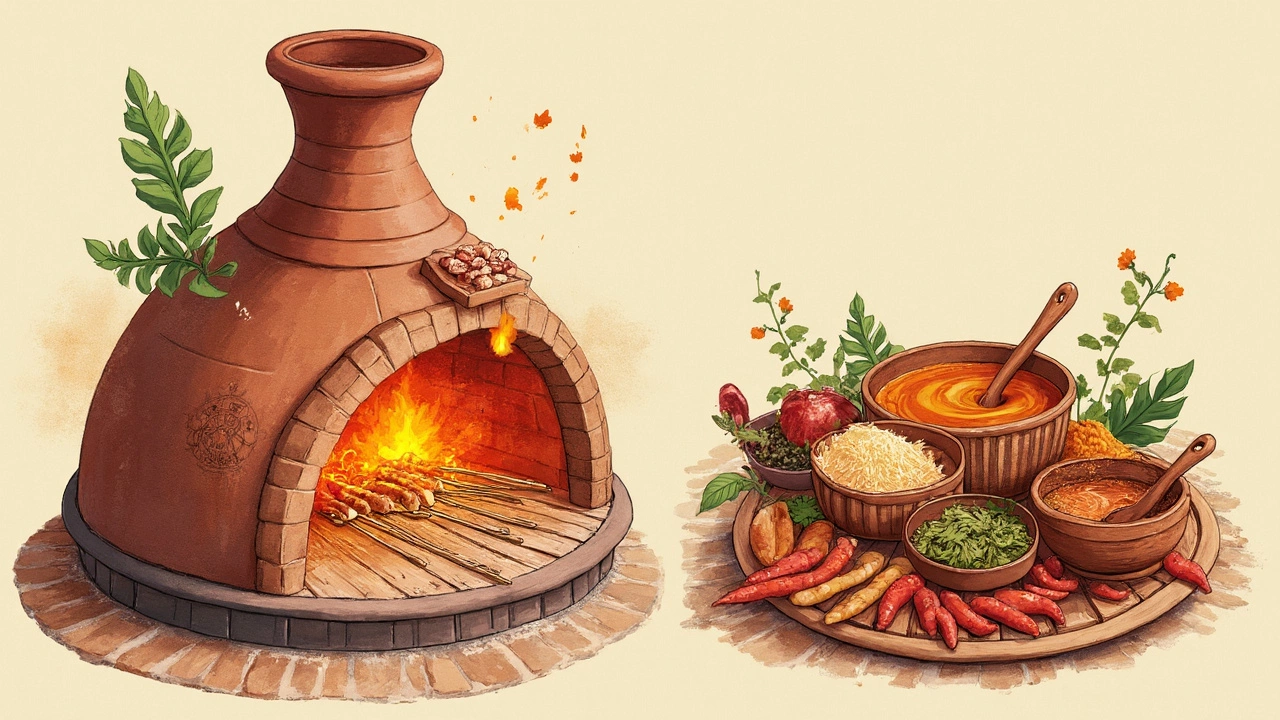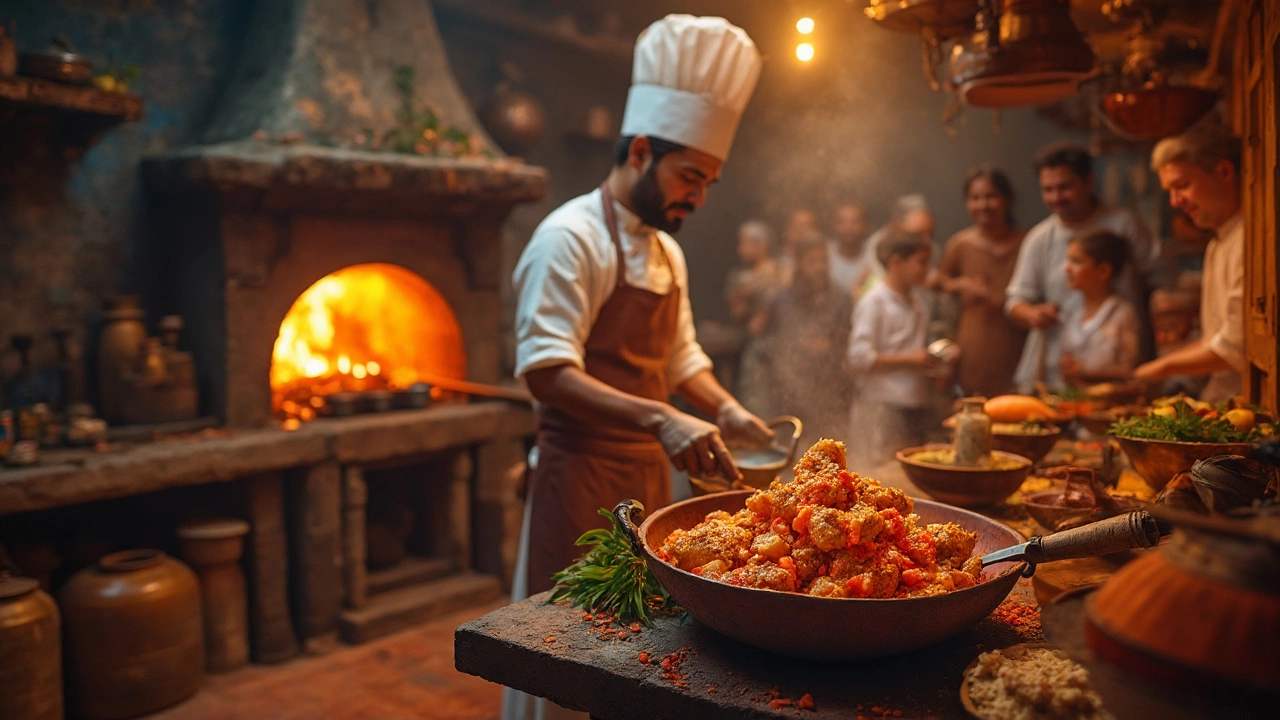You see 'tandoori' on menus, spice jars, and ready-to-eat meals, but what does that word actually mean? Does it point to a special mixture of spices or a type of oven? Turns out, you’re not alone if you’ve mixed them up. Even people who love tandoori chicken sometimes use the word both ways without thinking twice.
Tandoori isn’t really a single spice. It actually comes from the word ‘tandoor’—a super-hot clay oven used in India, Pakistan, and beyond. The word 'tandoori' just means food cooked inside that kind of oven. But in shops, you’ll find jars called ‘tandoori masala’ or ‘tandoori spice,’ which is where things get muddy.
If you want to make tandoori chicken at home, you don’t need to track down a giant clay oven to do it right. Knowing what makes something ‘tandoori’ helps you get the flavor, even in a regular kitchen. Before firing up the grill or preheating the oven, it helps to know the real story behind the word—and how you can fake that smoky, restaurant-style flavor at home.
- What Tandoori Really Means
- The Tandoor Oven Explained
- Tandoori Spice Mix: What's Inside?
- Cooking Tandoori-Style at Home
What Tandoori Really Means
If you’ve ever wondered why ‘tandoori’ is slapped on everything from chicken to veggie skewers, the secret is in the cooking style, not just the seasoning. The word ‘tandoori’ actually means food that’s cooked using a tandoor, which is a special type of oven that’s been used across South Asia for over 5,000 years!
A tandoor looks like a big, upright clay barrel. It gets cranked up to crazy-high temperatures (think 480–500°C, or almost 900°F). That heat is what gives tandoori chicken its signature charred edges and juicy inside. No other oven really matches that combination of smoky flavor and quick sear.
People sometimes think ‘tandoori’ is just about the reddish, spicy coating. Not really. It’s all about how the food goes into the tandoor oven—on long skewers or stuck right to the clay walls—and comes out sizzling. Even naan, the soft Indian bread, is pressed to the inside sides of the tandoor to cook in seconds.
| Misconception | Reality |
|---|---|
| Tandoori = a spice mix | It’s actually a cooking method using a tandoor oven |
| Tandoori only applies to chicken | It covers bread, veggies, lamb, and even fish |
| Tandoori food needs special ingredients | Main thing is the cooking technique, not the spice alone |
Here’s why this matters: If you’re after true tandoori-style food, the focus is on mimicking that powerful, smoky, quick-fire flavor—even if you’re cooking at home with a grill or oven. That’s the whole vibe of tandoori, whether you’re making classic chicken, paneer, or even tofu.
The Tandoor Oven Explained
If you picture a regular kitchen oven, you’re way off. A tandoor oven is a giant clay or metal pot, standing upright. It can reach up to 900°F (480°C). That’s much hotter than most grills at home. What’s wild is the way food cooks inside: the heat comes from burning charcoal or wood right at the bottom, so you get a mix of roasting, smoking, and grilling, all at once.
The real secret? The walls of the tandoor. Chefs slap marinated chicken or naan bread straight onto those scorching hot sides. The dough or meat sticks, cooks super fast, and comes out with that charred, smoky vibe you just can’t get in a pan. There’s no rotating meat or turning skewers much—gravity and heat do the work.
Tandoor ovens are common in India, Pakistan, Afghanistan, and even into Central Asia. In North India, some eateries are known for having tandoors running non-stop, sometimes for decades. Restaurants stock jumbo versions, but even home cooks are getting tiny countertop tandoors these days. If you ever see a chef whipping naan off the tandoor walls with hooked sticks, you know it’s the real deal.
Why are they so effective? The shape and insulation let them keep sky-high temps with less fuel. Plus, the unique clay adds its own earthiness to the food. Some chefs swear their tandoor’s flavor gets better every year it’s used—no joke!
Check out a quick comparison to your average kitchen gear:
| Oven Type | Max Temperature (°F) | Fuel | Signature Effect |
|---|---|---|---|
| Tandoor | 900 | Charcoal/Wood | Smoky char, fast cooking |
| Conventional Oven | 550 | Electric/Gas | Even, slow roasting |
| BBQ Grill | 700 | Charcoal/Gas | Char marks, variable heat |
If you’re after the taste of tandoori chicken like the pros, the oven makes a difference. But that doesn’t mean you have to splurge on a real tandoor—there are hacks to get halfway there, which I’ll get to soon.

Tandoori Spice Mix: What's Inside?
Ever grabbed a jar labeled 'tandoori masala' and wondered what actually goes in there? It’s not just one spice—it's a blend made for a punchy, colorful marinade. It’s that spice mix that gives tandoori chicken its bold flavor and classic red-orange look. You’ll usually spot pre-mixed tandoori masala in stores, but whipping up your own takes the guesswork out and actually tastes fresher.
Here’s what goes into a basic tandoori spice mix:
- Coriander and cumin: These are the backbone, giving earthy depth.
- Paprika: Mostly for the bright color and mild flavor. Sometimes Kashmiri red chili is used instead for more heat and color.
- Ginger and garlic powder: These bring fragrance and a bit of a kick.
- Turmeric: Adds a yellow tinge and extra earthiness.
- Garam masala: A mix inside the mix—cloves, cardamom, cinnamon, and more. This rounds out the flavor.
- Salt: Most store-bought blends include this.
- Some blends add fenugreek leaves (kasuri methi) or even a touch of dried mango powder for tang.
No two shops make it exactly the same, but if you’re making it at home, start with these basics. Feel free to tweak and taste. Some people like it hotter, other folks skip the chili. Want it extra smoky? Add a pinch of smoked paprika.
For marinating, the mix usually gets combined with yogurt and lemon juice, letting the flavors soak in and helping tenderize the meat. With this blend in your kitchen, you can flavor just about anything 'tandoori-style'—from veggies to paneer, not just chicken.
Cooking Tandoori-Style at Home
You don’t need a giant clay oven to make food with that famous tandoori flavor. Most people use regular ovens, grills, or even air fryers and still get awesome results. The big deal with tandoori dishes is the combo of marinade and high heat. The heat gives that crispy edge and smoky taste you recognize from restaurant tandoori chicken.
Let’s talk about the marinade. This mix usually starts with thick yogurt, which helps keep the meat juicy. Then comes the tandoori masala (yep, that’s the spice blend), garlic, ginger, lemon juice, and sometimes a bit of oil. The longer you marinate—think 4 to 8 hours—the better the flavor soaks in. Here’s a super-basic tandoori marinade recipe anyone can use:
- 1 cup plain yogurt
- 2 tablespoons tandoori masala
- 1 tablespoon lemon juice
- 1 tablespoon grated ginger (or ginger paste)
- 1 tablespoon garlic (or garlic paste)
- 1 teaspoon salt
Mix it all up, coat your chicken (or veggies, paneer, whatever), and let it rest in the fridge. A ziplock bag works great for this.
If you want to mimic a tandoor’s effect, crank up your oven as hot as it goes—usually 475°F to 500°F (about 240°C to 260°C). Place the marinated chicken on a rack or tray lined with foil. Some folks like to broil for the last few minutes to char the edges for that burnt, smoky touch.
Grilling is another way to get close to the real thing. Use skewers if you’ve got them, and be sure to flip halfway through for even color and grill marks. Hardwood charcoal beats gas for the smoky taste, but use what you have.
If you’re curious about cook times, here’s a handy table. It covers home-cooked tandoori chicken, so you get an idea of how long things take depending on your kitchen gear:
| Method | Temperature | Approx. Cook Time |
|---|---|---|
| Oven Bake | 475°F/245°C | 25-30 min |
| Oven Broil (Finish) | High | 2-4 min |
| Outdoor Grill | Medium-High | 15-20 min |
| Air Fryer | 390°F/200°C | 18-22 min |
No matter your method, let the meat rest for a few minutes once cooked. That way, juices stay inside and you don’t end up with dry chicken. If you want to get close to restaurant color, add a pinch of paprika or Kashmiri chili powder for that red-orange pop—totally optional, but it looks cool.
The real secret to great tandoori chicken at home? Get the marinade right, use high heat, and don’t be afraid to experiment. You really don’t need fancy gear—just patience and a hot oven or grill.
